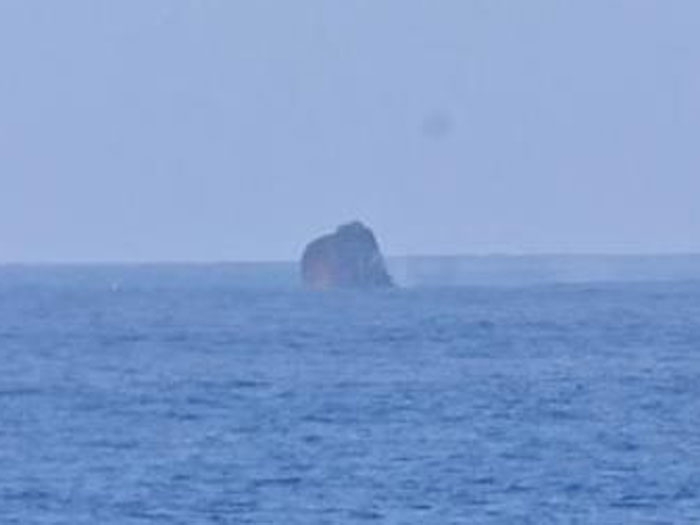
NTSB reports on sinking of 34 year old tugboat
Written by Nick Blenkey
Crew member of Clean Islands, one of the vessels that responded to distress call, got this shot of the skyward-pointing bow of the Nalani just before the vessel sank
AUGUST 26, 2015 — The National Transportation Safety Board (NTSB) has issued the report of its investigation of the sinking of the 34 year old tug Nalani on January 22 2015 off Oahu.
All 11 persons on board were rescued after abandoning the vessel. No one was injured. An oil sheen was observed by responders and crewmembers. The vessel was not salvaged due to the water depth and was declared a total constructive loss.
The NTSB determined that the probable cause of the flooding and eventual sinking of the Nalani was the captain’s decision to get under way without sufficient freeboard at the stern and without ensuring proper watertight integrity.
As ever, there’s more to this story than apparent from the bare bones of the NTSB’s executive summary. Following are some extracts from the full Marine Accident Briefing.
Built as the Nick Candies in 1981, the vessel it was acquired by Smith Maritime of Hawaiian Interisland Towing Inc. in 2004 and renamed Nalani. The vessel subsequently transferred owners several times and was taken out of service in February 2012 until 2014, when Vogel Equipment of San Francisco, CA, purchased to use to tow two barges from Honolulu to Chile. The selected operator for the transit to Chile was Panama-based Remolcadores de Altura.
The Nalani was reflagged from U.S. to Panama in January 2014, and went to Marisco Shipyard at Barbers Point, west of Honolulu, for repairs and upgrades.
While drydocked from March to April 2014, ultrasonic gauging measurements were made of the hull thickness and readings from the main deck, the 01 deck, the steering room bulkhead/decking, and the hull indicated wastage and deterioration of the steel.
The shipyard accordingly replaced and added steel, particularly around the steering compartment and aft peak tanks. The packing for the propeller shafts and rudder shafts was also replaced.
After the Nalani was refloated, work continued during an 8-month dockside repair period at the shipyard. It included extensive steel work, machinery repairs, and tank cleaning. Two generators were replaced and several new pieces of equipment were added, including an emergency generator, an inflatable auxiliary boat with a steel platform and davit system, and various communications equipment. The fuel, ballast, and potable water tanks were emptied for cleaning and maintenance.
Most of the crew from Panama joined the Nalani in late November 2014 and worked throughout the vessel, cleaning, chipping, and painting. They added the platform for the new inflatable boat, steel rails for the liferafts, and a steel base for the new emergency generator.
On December 21, 2014, the Nalani departed the yard, transited to Honolulu harbor, and loaded 77,700 gallons of marine diesel fuel in preparation for the upcoming voyage to Chile. About 50,000 gallons of the fuel were stored in tanks in the aft section of the vessel (no. 3 port/starboard fuel oil tanks and the no. 4 fuel oil tank). These three tanks were located under the stern deck.
On the return trip to the shipyard, the Nalani’s bow began taking on sea water through rust holes behind the fendering tires in the hull. From the stern, the steering space began to flood through leaking hatch seals that were flush with the deck and allowed sea water to enter the steering space.
After the vessel arrived at the shipyard the following day, says the NTSB report, a shipyard manager remarked that he had never seen a tugboat’s stern so deep and estimated that the Nalani had only about 3 inches of freeboard at the stern. This excessive stern trim resulted from the majority of fuel being loaded in the aft section of the vessel and the water tanks in the forward section being empty.
At the shipyard, both steering hatch covers were replaced with raised-combing-type hatch covers, and the holes on the bow were repaired by welding steel doublers over the holes.
On January 15, 2015, the Nalani departed Marisco Shipyard to transport the two barges from Honolulu to Barbers Point.
While towing the barges back to the shipyard the following day, the autopilot for the steering system failed and the towline became entangled in the portside propeller.
A technical representative was called in to repair the autopilot system. While on board for the autopilot repair, he was asked to install a new bilge alarm in the steering space, since it had flooded on the previous trip. The new bilge alarm was installed by wiring it into the existing port engine room bilge circuit; however, the label for this alarm had not been revised at the time of the sinking to reflect the addition of this new steering space bilge alarm and remained labeled as “port engine room.”
On January 17, 2015, Panama Naval Services conducted a survey of the Nalani and found it to be “in working condition and fit for their trade.”
Departure for Chile with the two barges in tow was planned for Friday, January 23, 2015, with a 30-minute sea trial of the autopilot system was scheduled for 1500 on January 22, 2015.
A Hawaii state pilot was requested to join the sea trial, and he arrived about 1415.
Earlier that same morning, an owner’s representative directed a shipyard worker to cut out a 20-inch-diameter welded steel plate cover from the starboard side of the stern deck above the starboard aft peak tank. (Steel plates had been welded in place of bolted hatch covers the previous year due to water leakage into the aft peak tanks.) The shipyard worker was told to replace the 20-inch plate with a raised-combing hatch cover, which had threaded bolts for securing. After the steel plate was cut and removed, the shipyard worker went ashore to drill the new cover, but when he returned about 1435, the Nalani had already departed for the sea trial.
The crew on board the vessel temporarily placed a piece of gasket material over the 20-inch hole in place of the steel cover. This remedy, however, left the starboard aft peak tank vulnerable to water intrusion and progressive downflooding.
The captain told investigators that he was aware of the unsecured opening but decided to get under way for the sea trial anyway.
During the sea trial, 11 persons were on board. When the Nalani departed the shipyard, the fore peak tank (max. capacity 3,500 gallons), the no. 1 ballast tank (max. capacity 20,466 gallons), the potable water tank (max. capacity 8,580 gallons), and both of the aft peak tanks (for a combined max. capacity of about 7,000 gallons) were empty. The pilot reported that the vessel maneuvered out of the harbor at a speed of about 5.5 knots.
After the Nalani cleared Barbers Point Channel, the captain relieved the pilot and successfully completed the autopilot tests on both the port and starboard steering pumps. The sea state and low stern freeboard caused the stern deck to be awash with sea water as the vessel transit continued. When water flowed over the stern deck, the starboard aft peak tank began filling with water through the unsecured opening.
The pilot became aware of the flooding and notified the captain of his concerns. The captain then reduced speed and made a long 180-degree port turn back toward the shipyard. This direction put the sea swells on the stern and increased the rate of flooding. At this time, most of the deck crewmembers were in the wheelhouse and the engine department members were in the engine room.
At 1513, the pilot radioed the United States Coast Guard on channel 16, broadcast a distress call, and advised that the Nalani was sinking and was instructed to have the crew don lifejackets. Two nearby vessels immediately replied to the distress call.
The pilot remained in radio contact with the Coast Guard, providing constant updates and receiving instructions since none of the crew was fluent in English. He asked the chief engineer for the status of the engine room. The chief engineer checked the engine spaces and advised that no water was entering the engine room, but that the aft peak tank was flooding because the cover was not sealed.
The pilot relayed this information to the Coast Guard, reporting that the stern was under water but that the vessel was slowly making its way back to the harbor. The Coast Guard requested that dewatering equipment be used to start pumping out the affected space.
The bilge alarm, labeled in the wheelhouse as “port engine room,” activated, which the crew attributed to water sloshing around in the engine room bilges.According to the tech rep who installed the alarm, it was likely activating for the steering space (as the label in the wheelhouse alarm panel had not been updated).
Less than a minute later, the Nalani suddenly began listing heavily to port, and the captain sounded the general alarm.
The pilot ordered the engines to be stopped, the crew to move to the high side of the vessel, and then to abandon ship.
All 11 persons entered the water; the pilot counted everyone and notified the Coast Guard via handheld radio that all persons were off the vessel. Some of the crewmembers were able to board the inflatable auxiliary boat and a liferaft that released from the vessel.About 1531, the Nalani listed 45 degrees to port and, about 2 minutes later, 90 degrees to port. About 1533, the stern sank beneath the waves, the bow pointed toward the sky, and the vessel slid beneath the surface and sank at a water depth of about 2,200 feet.
Read the NTSB’s full Marine Accident Brief HERE





Leave a Reply
You must be logged in to post a comment.